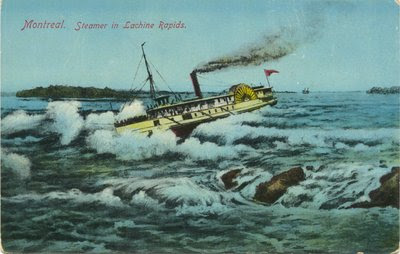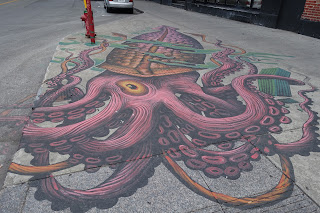This morning we woke to a clear blue sky and lots of sun. In the last 30 minutes clouds have rolled in and we are expecting thunderstorms. That pretty much sums up the changeable weather of the last week. Mostly sunny with a day or two of sometimes rain. We had one day of Florida weather: really hot, humid, ending in a thunderstorm. But mostly it's been in the 70s and low 80s. Perfect weather for walking. And that's what we do a lot of...walk.
Favorite Walks of the Week. On our one day of hot and humid Florida weather we took to the "Underground City." Underneath downtown Montreal is a rabbit warren of climate-controlled passageways that connect office buildings, metro stations, food courts, the main train station, shopping malls, and public spaces. In the winter, this Underground City is well used to escape the frigid winter winds. In the summer, it isn't as busy...but we find it a great place to still get in an explore while not sweating like we were home in Florida.
 |
| Jerry in the Underground City |
On a milder day, we walked along a portion of the Lachine Canal from Old Montreal to the up and coming (former working class neighborhood) Griffintown.
 |
| Stadning at Lock 2 on the Lachine Canal looking back towards the Old Port of Montreal |
The Story of the Lachine Canal. Montreal sits on the St. Lawrence River which drains the Great Lakes (Lake Ontario) and flows northeast to the Atlantic Ocean.
Before the Lachine canal (built in the mid 1800s) the great Lachine Rapids was a major hazard to boats on the river. It was simply impossible for large boats to get through safely on a regular basis.
So in the mid 1800s, industrious Montrealers dug an 11-mile long canal from the Port in Old Montreal to Lachine (a former fur trading town.) Over the next century the canal (and it's lock system) was enlarged and improved a number of times.
By the 1920s Montreal was the 5th largest inland port in the world and was the largest grain shipping port in the world. All that wheat grown across the heartland of Canada was shipped by train to ports along the St Lawrence. It was put on canal barges in Lachine and taken down the canal to Montreal where it was loaded onto large ships for transport to cities all over the world.
The building that our apartment is in was built around 1850 arond the time the Lachine Canal opened and Montreal was rapidly growing as a port city. The building would have had shops on the first floor to serve the shipping trade and warehousing on the upper floors. This engraving is of Montreal in 1889. Our building is in the center directly facing on the port.
Ships got bigger and eventually the Lachine Canal was too narrow and the locks too short and shallow for the big "lakers" that hauled grain and other goods to and from the Great Lakes. So in the 1950, the St Lawrence Seaway (built on the other side of the river from MOntreal) was built. The Lachine Canal closed and decayed over a number of decades. In the late 1990s/early 2000, an effort was made to restore a portion of the locks and canal to be used for pleasure boaters. It was very successful and once again, the Lachine Canal lives. (Along with a walking and biking path that runs the entire length of the canal).
We Love Montreal's Nature Parks. Our two favorite parks in Montreal are the Parc-des-Rapides (which sits on on of the many "legs" of the Lachine Rapids) and the Parc Bois-des-i'lle-Bizard. We visited both last week. The Parc-des-Rapides was filled with blooming day lilies, red-winged black birds, terns fishing along the shore, herons and egrets standing amidst the reeds, and a wonderful cool breeze coming in off the river.
 |
| Look closely and you can see a tern hovering and fishing over the rapids. |
After Walking Comes the Eating. All the walking built up an appetite. This week's highlights were Montreal's famous smoked meat, fresh oysters and mussels, crepes, pie, and, of course, more ice cream.
Montreal is famous for their style of smoked meat (like what we call pastrami south of the border). The most famous spot is Schwartz's on St Laurent which we've been to many times. But this time of year (festival season) the lines out front are huge. All. Day. Long. So we slipped across the street to Le Main which has really good smoked meat sandwiches as well (and no line).
(For a great discussion of the "war between the meats" or "what the heck is the difference between smoke meats and pastrami" check out this great blog post by Ben Jay on SeriousEats.com What's the Difference Between Smoked Meat and Pastrami?)
I love Oysters, Jerry loves mussels. So Maestro SVP on St Laurent is the perfect ticket for us. They will usually have about 20 different types of oysters on offer (most from the Canadian maritimes and a few from the U.S. Northeast and Canada's British Columbia.) On Mondays, they have "all you can eat" mussels and "happy hour" Beausoleil oysters for a great price. So that's where we headed last Monday. I tried 9 different kinds of oysters. All were great, but I once again confirmed that I'm a Northwest Oyster gal at heart...the Kuushi and Valentine oysters from British Columbia were spectacular! Yum!
And let's not forget the sweets. We made a pilgrimage to Bilboquet
ice cream shop in the Outremont neighborhood of Montreal. FANTASTIC caramel and dark chocolate scoops. But they didn't have strawberry that day to taste test. Will just have to return. Darn!
And then there was pie. You knew I'd have to eventually get around to pie, didn't you? My favorite pie place in Montreal is Rustique Pie Kitchen in the St-Henri neigborhood. The specialize in "tiny" pies (although they offer full size pies, cookies, bar cookies, and meringues as well). I had the meringue citron (lemon meringue), cerises (cherry), and banana split pies. Delish!
Murals, Murals, Murals. We've taken to getting on a bus and taking it about 2 to 3 miles away from our flat and then getting off and walking back home. Trying different routes or revisiting old favorites. What they all have in common are murals. Big ones, little ones. Old ones, new ones. "Official" ones and really great graffiti. Here are some of this weeks finds:
Old and New. Montreal is a living, breathing, modern City built on the bedrock of over almost 375 years of history. Next year will be the City's 375th birthday and the City has got projects going everywhere to be ready to celebrate (so NEXT year's blogposts will be full of all that fun!) But it is the mix of old and new that we like so much on our walks.
The Old Walls. In the early days of Montreal (375 years ago), the original city/fort had a wooden blockade built around it for protection. Later that wooden wall was replaced by a stone wall that enclosed a much larger town. It got taller and bigger as the town grew into City. Eventually the City grew far past the old walls and was no longer needed. So the walls were torn down or built on. There are only two places you can see remnants of the wall. One is underground at the nearby Pointe -a- Calliere Museum and the other is in the grassy park of Champ-de-Mars. This photo shows what would have been the foundations of the stone walls in the early 1700s.
(side note: when they were renovating our building and enlarging the subterranean area for more parking spaces, they came across the remains of the early wall. So we sit right on top of where the wall once was)
More recently there was a major new hospital built not too far from us. It was a much needed hospital associated with the University of Montreal. There was an old church that had been vacant for many years. The Eglise St Saveur was originally built in 1865. It was demolished for the hospital construction but the portion of the church that had served as the entranced (topped by a steeple) was carefully "deconstructed" and then rebuilt on the corner of Rue St Denis and Viger.
A Bientot!

















1 comment:
This is so great have never been to Canada so enjoying learning from your weekly blog thank you
Post a Comment